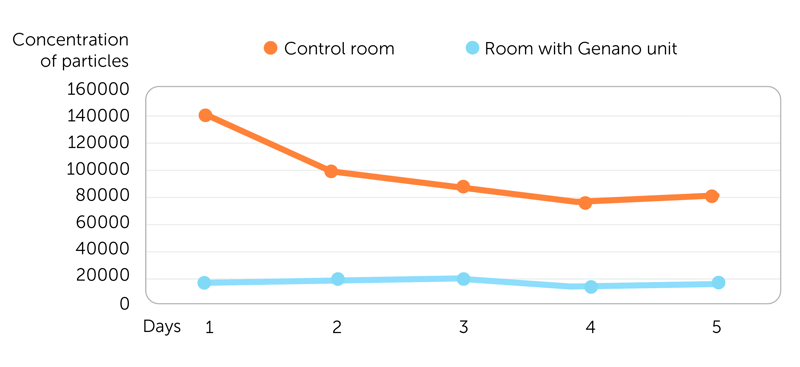Hospital-acquired infections are referred to as nosocomial infections when the patient has been admitted for a cause other than the infection and, at the time of admission, did not show signs of an ongoing infectious disease incubation. Infections associated with healthcare (ICA) have a significant clinical impact, as they constitute the most frequent and severe complication related to healthcare, resulting in:
- Prolonged hospital stays
- Long-term disability
- Increased use of antibiotics
- A considerable increase in hospital costs
- Increased workload for staff
- Increased reliance on laboratory tests, etc.
To ensure environmental quality in hospital premises, in addition to maintaining the correct thermo-hygrometric parameters, it is necessary to remove as many dust particles as possible and periodically carry out bio-decontamination to maintain microbial counts within controlled levels. However, technology alone is not sufficient to effectively combat the problem of environmental contamination; instead, an effective and efficient organization of the service as a whole is necessary, which must necessarily involve all stakeholders in this type of service.
Testing of the Genano continuous air decontamination system in high-risk environments at the Azienda Tutela Salute Sardegna ASSL Olbia

The study was conducted by the personnel of DMP Giovanni Paolo II in Olbia in conjunction with Biomedical Engineering at Te.Mo.Sa Srl, with the aim of studying the in vitro variation of microbial contamination in closed healthcare environments that have air treatment systems installed.


Study Purpose
The research described here aims to:
- Study the in vitro variation of contamination in closed healthcare environments (in operation) where Genano air treatment technology is installed.
- Evaluate if the Genano air treatment system can be effectively associated with a 35% HPV bio-decontamination protocol.
- Assess the functionality of the entire process in order to prevent recontamination phenomena. The need arises from the fact that, although various methods have been proposed and developed to improve the cleaning and disinfection of surfaces, often based on the use of chemical compounds with a significant environmental impact, and although conventional procedures are effective in the short-term reduction of most pathogens, the difficulty of preventing recontamination phenomena persists.
Study Planning
After careful market research on air treatment technologies, aimed at identifying a certified product that could be associated with the efficacy of high-concentration vaporized hydrogen peroxide, the choice fell on the Genano G5250A air decontamination device. Its purification capacity is 500 m3/h, effective for particles >0.003 μm, transportable on wheels, and with an efficiency of 99.5% reduction. This model, when paired with a special kit, can create positive or negative pressure, adapting to all environments, including clean rooms, laboratories, or isolation rooms.
Regarding the experimentation methods, the study was organized into three phases:
- Analysis of environmental contamination under normal conditions (T0).
- Analysis of environmental contamination with the Genano® 5250A air treatment system active for 24 hours (T1).
- Analysis of environmental contamination under normal conditions with the Genano® 5250A air treatment system turned off for 24 hours (T2).
Materials and Methods
The analysis of environmental contamination was conducted through the following measurements with accompanying instrumentation:
- Particle count according to UNI EN ISO 14644-1.
- Quantification of total mesophilic bacterial load (CBT) according to UNI EN 13098-2002.
- Environmental bio-decontamination with 35% HPV, certified through biological and chemical indicators.
Results
From the reported data, it's evident that Genano's use within 24 hours reduced particle concentration per cubic meter by approximately 80%, promoting a more uniform distribution within the environment compared to initial conditions.
Moreover, after turning off the Genano system and routine room usage, particle concentration increased by about 300% compared to the conditions when Genano was in use.
Based on particle concentration, it's possible to assess the ISO classification of the rooms. Considering 0.5 μm particles, the Digestive Endoscopy room would classify as ISO 7 in T0 and T2 conditions, while improving to ISO 6 when Genano is operational (T1).
Digestive Endoscopy
The graph below shows the data for the visual verification of particle concentration before, and during the use of the Genano system.

Conclusions
The fact that the Genano device can reduce particulate matter, improving the ISO classification of the room in which it is installed, demonstrates that combining the bio-decontamination protocol with continuous air treatment using the Genano system (in addition to proper surface sanitation) can be considered one of the optimal solutions for maintaining the risk of healthcare infections at levels deemed acceptable by Medical Directors, especially in areas defined as "high risk."
The importance of having a corporate protocol that includes:
A.
Integration of HPV bio-decontamination into currently adopted sanitation procedures, based on risk assessment and "on-call" in the case of external contamination.
B.
Integration of the VCCC system with standalone or ducted continuous air treatment systems to improve effectiveness and efficiency.
The study has also highlighted the significant insight that inadequate ventilation, besides being a potential cause of respiratory infections and healthcare-associated infections, can lead to "Sick Building Syndrome."
The quality of air in hospitals, both as a residence, diagnosis, and care location for patients, and as a workplace for staff, is increasingly perceived as one of the determining factors not only for the quality of life but also for the quality of healthcare and professional performance. Therefore, careful management and monitoring of air quality and the processes of sanitation, bio-decontamination, and maintenance of environments in ideal conditions are vital to reduce these risks and improve the quality of healthcare.
.png)